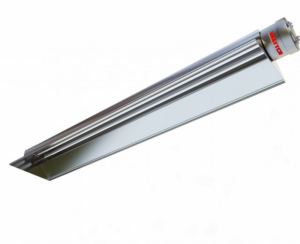5 Benefits of Industrial Infrared Heating
 While convection and conduction heating are staples in many industries, radiation heating is less ubiquitous. However, radiation heating—namely, infrared heating—has its advantages when used for industrial applications and should not be overlooked.
While convection and conduction heating are staples in many industries, radiation heating is less ubiquitous. However, radiation heating—namely, infrared heating—has its advantages when used for industrial applications and should not be overlooked.
-
Lower energy consumption
Infrared radiant heaters are energy efficient because they transfer energy directly to their target medium. With no hindrances between the heater and its target, virtually 100 percent of the heat is absorbed. Research has also found that facilities using infrared heating can save up to 20 percent to 50 percent in fuel costs.
-
Reduced harmful emissions
With more governments pushing to reduce industrial carbon footprints, corporations are scrambling to find greener heating solutions. Infrared radiant heating helps them meet these demands. Unlike heaters that use fossil fuels for power, radiant heaters use electricity to generate power, releasing excess energy as heat. They burn clean as a result, with virtually no emissions.
-
Thermal stratification
Air circulation drastically affects occupants’ perception of warmth for comfort heating applications. Specific forms of heating provide sufficient heat, but poor stratification makes the heat less perceptible. Radiant heaters, on the other hand, reduce thermal stratification so occupants can feel the heater’s warmth. That said, the orientation of a heater can alter how the heat disperses.
-
Increased air quality
The air in most facilities contains ample amounts of hazardous particles and pollutants. Many types of heaters need air currents to transfer heat, which, in turn, circulate these particles. Infrared heaters don’t use air currents to transmit heat and, therefore, don’t spread hazardous airborne matter. That is a crucial advantage for settings containing flammable or toxic air particles.
-
Durability and longevity
Heater maintenance is a significant concern for companies. The cost of maintaining heaters is usually high due to the number of working parts and their reliance on external power supplies. Infrared heaters differ because they contain fewer components and, by extension, are less likely to break down. When repairs are necessary, they’re usually minimal and late in the heater’s lifecycle.
Applications of indoor infrared heating
Infrared heating is already a staple method for various industries and particular applications. It’s possible that your industry and application already use infrared heating; if so, it may be a viable heating option for your facility.
Uses of infrared radiant heating
-
- Medical applications: Medical labs, hospital wards, and clinics use infrared heating for applications such as platelet separation (from blood) and sterilization of medical equipment.
- Automotive sector: Manufacturers of automotive parts often use infrared heaters to dry and anneal car parts due to their rapid heating capacity.
- Mining, oil, and gas industry: Infrared heating in the mining and oil industries eliminates oil-laced sand from crude oil tanks.
- Construction/manufacturing sector: Infrared heaters can help bind construction materials, especially those needed for highly demanding environments.
- Packaging industry: Companies in the packaging industry use infrared heat for thermoforming techniques due to radiant heating’s energy-saving benefits.
Choosing a Wattco radiant heater
The key to finding an efficient radiant heater is to match its output with the needs of your application. Although infrared heaters deliver direct, intense heat where required, other considerations are still necessary. That may include the size of the target space and the required temperature for the application at hand.
Here at Wattco, we offer pre-constructed and customizable infrared radiant heaters that suit your unique industrial operations. Based on your needs, we will advise you on the most suitable heating element design and materials, along with other specifications such as wattage and heater size.
Get a quote for your infrared radiant heater today. Our representatives will help you find the exact setup needed for your industrial needs.
